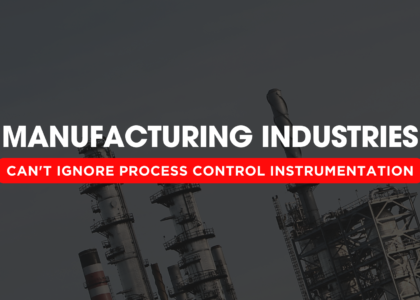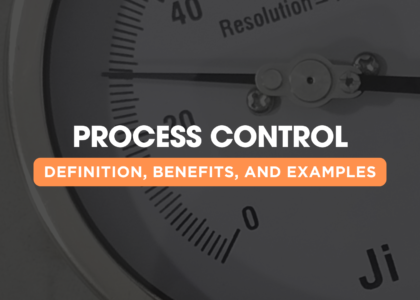Process control is a critical aspect of manufacturing and industrial operations, ensuring processes run efficiently, safely, and consistently. The instruments used in process control are varied and highly specialized, tailored to meet the specific needs of different industries and applications. This blog will explore the key types of process control instruments and their applications in various sectors.
Table of Contents
Introduction to Process Control
Process control involves the use of various instruments and technologies to manage and regulate the output of industrial processes. The primary goals are to maintain product quality, ensure safety, and optimize operational efficiency. Instruments used in process control include sensors, transmitters, controllers, and actuators, among others.
Importance of Process Control
- Consistency: Ensures uniformity in production, which is crucial for maintaining product quality.
- Efficiency: Optimizes resource use, reducing waste and energy consumption.
- Safety: Helps in maintaining safe operating conditions, preventing accidents.
- Compliance: Assists in meeting regulatory standards and guidelines.
Key Types of Process Control Instruments
1. Sensors
Sensors are the frontline instruments in process control, responsible for measuring various process variables. These measurements are critical for monitoring and controlling industrial processes.
Types of Sensors and Applications
a. Temperature Sensors
Temperature is a vital parameter in many industrial processes. Temperature sensors measure the heat level within a process.
- Thermocouples: Used in high-temperature applications like furnaces and reactors due to their wide temperature range and durability.
- Resistance Temperature Detectors (RTDs): Known for high accuracy and stability, suitable for precision applications like chemical processing.
- Thermistors: Used in applications requiring fast response times, such as HVAC systems and consumer electronics.
b. Pressure Sensors
Pressure measurement is essential in processes involving gases and liquids.
- Piezoelectric Sensors: Ideal for dynamic pressure measurements in engines and turbines.
- Capacitive Sensors: Used in applications requiring high sensitivity and accuracy, such as leak detection systems.
- Strain Gauge Sensors: Common in hydraulic systems and weather forecasting instruments.
c. Flow Sensors
Flow sensors measure the rate of fluid movement in a process, crucial for maintaining proper flow rates in various systems.
- Ultrasonic Flow Meters: Suitable for non-invasive measurements in water treatment and chemical processes.
- Magnetic Flow Meters: Used in conductive liquid applications like slurry and wastewater treatment.
- Turbine Flow Meters: Common in oil and gas industries for measuring liquid and gas flow rates.
d. Level Sensors
Level sensors determine the height of liquids or solids within a container, vital for inventory management and process control.
- Ultrasonic Level Sensors: Non-contact sensors used in wastewater treatment and chemical storage tanks.
- Capacitive Level Sensors: Suitable for measuring the level of various materials, including liquids, granules, and powders.
- Radar Level Sensors: Used in harsh environments like mining and bulk solids handling.
2. Transmitters
Transmitters convert sensor signals into standardized output signals that can be used by controllers and other devices.
Types of Transmitters and Applications
a. Temperature Transmitters
Temperature transmitters convert the signals from temperature sensors into a standardized form, such as 4-20 mA.
- Head-Mounted Transmitters: Ideal for space-constrained environments, used in food processing and pharmaceuticals.
- Field-Mounted Transmitters: Suitable for harsh conditions, common in petrochemical and power industries.
b. Pressure Transmitters
Pressure transmitters convert pressure sensor readings into electrical signals for monitoring and control purposes.
- Differential Pressure Transmitters: Used in flow measurement, filtration, and level monitoring applications.
- Absolute Pressure Transmitters: Suitable for vacuum and low-pressure measurements in semiconductor manufacturing.
- Gauge Pressure Transmitters: Common in HVAC systems and fluid power applications.
c. Flow Transmitters
Flow transmitters provide flow rate information by converting sensor data into standardized signals.
- Electromagnetic Flow Transmitters: Used in water and wastewater treatment for accurate and reliable measurements.
- Vortex Flow Transmitters: Suitable for steam and gas applications in power plants and chemical industries.
- Coriolis Flow Transmitters: Ideal for mass flow measurement in the food and beverage industry.
d. Level Transmitters
Level transmitters provide information on the height of materials within containers.
- Ultrasonic Level Transmitters: Used in applications where non-contact measurement is required, such as in corrosive environments.
- Hydrostatic Level Transmitters: Common in water and wastewater management for submersible level measurement.
- Radar Level Transmitters: Suitable for bulk solids and liquid level measurement in storage silos and tanks.
3. Controllers
Controllers are devices that receive signals from transmitters and process them to generate control actions. They are crucial in maintaining desired process conditions.
Types of Controllers and Applications
a. PID Controllers
PID (Proportional-Integral-Derivative) controllers are widely used due to their precise control capabilities.
- Single-Loop PID Controllers: Used in simple control systems like temperature control in ovens.
- Multi-Loop PID Controllers: Suitable for complex processes involving multiple variables, such as chemical reactors and HVAC systems.
b. PLCs (Programmable Logic Controllers)
PLCs are versatile controllers used in automation and process control applications.
- Compact PLCs: Ideal for small-scale automation in packaging and assembly lines.
- Modular PLCs: Suitable for large-scale and complex automation systems in manufacturing plants and water treatment facilities.
- Safety PLCs: Used in critical applications where safety is paramount, such as in oil and gas refineries.
c. DCS (Distributed Control Systems)
DCS systems are used in large, complex processes where multiple control loops are involved.
- Process Industries: Common in oil refining, petrochemical production, and power generation due to their scalability and reliability.
- Pharmaceutical Manufacturing: Ensures precise control over complex production processes, maintaining product quality and compliance.
4. Actuators
Actuators are devices that convert control signals into physical actions, such as opening a valve or starting a motor.
Types of Actuators and Applications
a. Electric Actuators
Electric actuators use electrical energy to produce motion and are known for their precision and ease of integration.
- Rotary Electric Actuators: Used in valve control in water treatment plants and HVAC systems.
- Linear Electric Actuators: Suitable for conveyor systems and robotic arms in manufacturing.
b. Pneumatic Actuators
Pneumatic actuators use compressed air to generate motion, offering fast response times and high force output.
- Diaphragm Actuators: Common in valve control applications in chemical processing and oil and gas industries.
- Piston Actuators: Used in applications requiring high force, such as in heavy machinery and material handling.
c. Hydraulic Actuators
Hydraulic actuators use fluid pressure to create motion, known for their strength and ability to handle heavy loads.
- Linear Hydraulic Actuators: Used in construction equipment and industrial presses.
- Rotary Hydraulic Actuators: Suitable for applications requiring high torque, such as in marine and aerospace industries.
5. Control Valves
Control valves are used to regulate the flow of fluids by varying the size of the flow passage.
Types of Control Valves and Applications
a. Globe Valves
Globe valves are used for precise flow control and are common in industries requiring tight shut-off capabilities.
- Steam Control: Used in power plants and heating systems.
- Process Control: Suitable for chemical and pharmaceutical manufacturing.
b. Ball Valves
Ball valves offer excellent sealing and are used in applications requiring quick on/off control.
- Oil and Gas: Used in pipelines and refinery operations.
- Water Treatment: Common in water distribution systems and wastewater treatment plants.
c. Butterfly Valves
Butterfly valves are used for regulating flow in large pipes and offer a compact design.
- HVAC Systems: Used in air handling units and duct systems.
- Food and Beverage: Suitable for hygienic applications due to their easy-to-clean design.
6. Analyzers
Analyzers measure the chemical composition of substances, providing critical data for process control.
Types of Analyzers and Applications
a. Gas Analyzers
Gas analyzers detect and quantify gases in a mixture, essential for environmental monitoring and process control.
- Emission Monitoring: Used in power plants and manufacturing to monitor and control emissions.
- Safety Monitoring: Common in confined spaces and hazardous environments to detect toxic gases.
b. Liquid Analyzers
Liquid analyzers measure the properties of liquids, such as pH, conductivity, and dissolved oxygen.
- Water Quality Monitoring: Used in water treatment and environmental monitoring.
- Chemical Processing: Ensures the proper chemical composition in manufacturing processes.
c. Spectrometers
Spectrometers analyze the spectral composition of light to determine the characteristics of materials.
- Pharmaceuticals: Used in drug development and quality control.
- Environmental Science: Common in air and water pollution analysis.
Conclusion
Process control instruments are indispensable in modern industrial operations, providing the means to monitor, regulate, and optimize processes. From sensors and transmitters to controllers, actuators, and analyzers, each instrument plays a vital role in maintaining efficiency, safety, and quality in various industries. Understanding the types and applications of these instruments is crucial for professionals involved in process control and automation, ensuring they can select and implement the right tools for their specific needs.
By leveraging advanced process control instruments, industries can achieve greater precision, reliability, and efficiency in their operations, paving the way for innovation and growth in an increasingly competitive market.
Japsin Instrumentation – Since 1974







